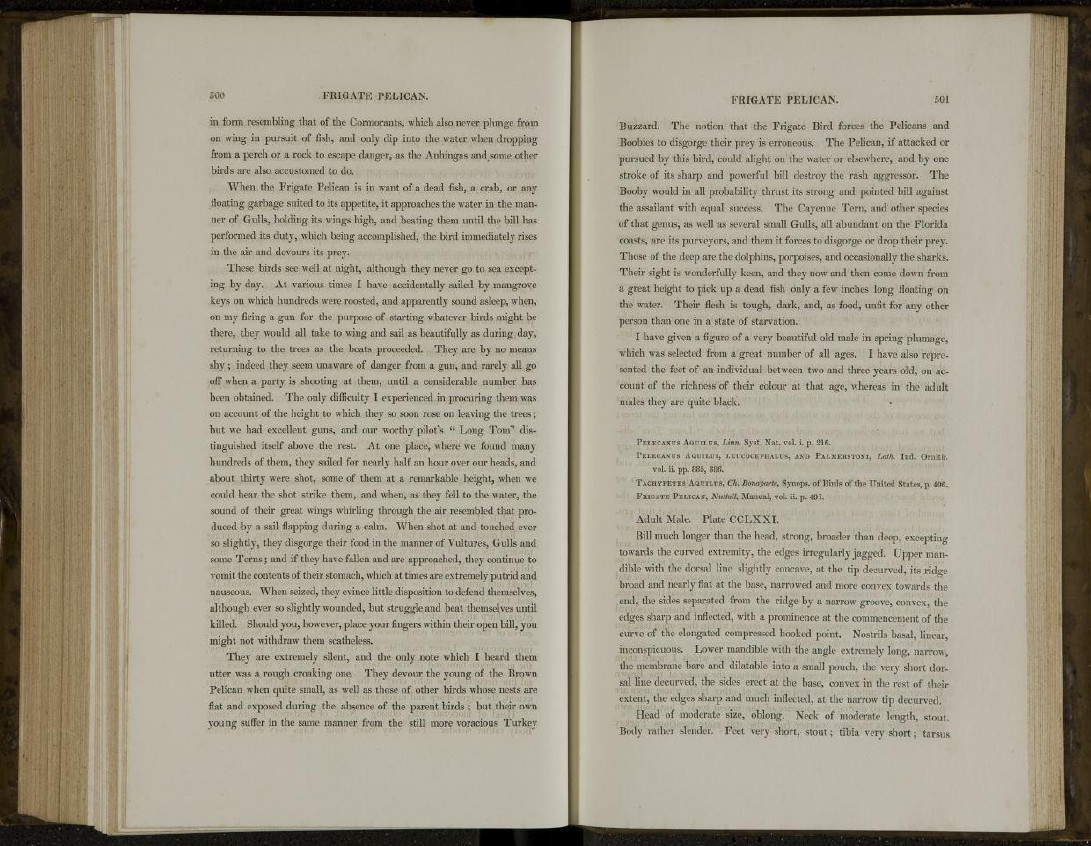
in form resembling that of the Cormorants, which also never plunge from
on wing in pursuit of fish, and only dip into the water when dropping
from a perch or a rock to escape danger, as the Anhingas and some other
birds are also accustomed to do.
When the Frigate Pelican is in want of a dead fish, a crab, or any
floating garbage suited to its appetite, it approaches the water in the manner
of Gulls, holding its wings high, and beating them until the bill has
performed its duty, which being accomplished, the bird immediately rises
in the air and devours its prey.
These birds see well at night, although they never go to sea excepting
by day. At various times I have accidentally sailed by mangrove
keys on which hundreds were roosted, and apparently sound asleep, when,
on my firing a gun for the purpose of starting whatever birds might be
there, they would all take to wing and sail as beautifully as during day,
returning to the trees as the boats proceeded. They are by no means
shy ; indeed they seem unaware of danger from a gun, and rarely all go
off when a party is shooting at them, until a considerable number has
been obtained. The only difficulty I experienced in procuring them was
on account of the height to which they so soon rose on leaving the trees;
but we had excellent guns, and our worthy pilot's " Long Tom" distinguished
itself above the rest. At one place, where we found many
hundreds of them, they sailed for nearly half an hour over our heads, and
about thirty were shot, some of them at a remarkable height, when we
could hear the shot strike them, and when, as they fell to the water, the
sound of their great wings whirling through the air resembled that produced
by a sail flapping during a calm. When shot at and touched ever
so slightly, they disgorge their food in the manner of Vultures, Gulls and
some Terns; and if they have fallen and are approached, they continue to
vomit the contents of their stomach, which at times are extremely putrid and
nauseous. When seized, they evince little disposition to defend themselves,
although ever so slightly wounded, but struggle and beat themselves until
killed. Should you, however, place your fingers within their open bill, you
might not withdraw them scatheless.
They are extremely silent, and the only note which I heard them
utter was a rough croaking one. They devour the young of the Brown
Pelican when quite small, as well as those of other birds whose nests are
flat and exposed during the absence of the parent birds ; but their own
young suffer in the same manner from the still more voracious Turkey
Buzzard. The notion that the Frigate Bird forces the Pelicans and
Boobies to disgorge their prey is erroneous. The Pelican, if attacked or
pursued by this bird, could alight on the water or elsewhere, and by one
stroke of its sharp and powerful bill destroy the rash aggressor. The
Booby would in all probability thrust its strong and pointed bill against
the assailant with equal success. The Cayenne Tern, and other species
of that genus, as well as several small Gulls, all abundant on the Florida
coasts, are its purveyors, and them it forces to disgorge or drop their prey.
Those of the deep are the dolphins, porpoises, and occasionally the sharks.
Their sight is wonderfully keen, and they now and then come down from
a great height to pick up a dead fish only a few inches long floating on
the water. Their flesh is tough, dark, and, as food, unfit for any other
person than one in a state of starvation.
I have given a figure of a very beautiful old male in spring plumage,
which was selected from a great number of all ages. I have also represented
the feet of an individual between two and three years old, on account
of the richness of their colour at that age, whereas in the adult
males they are quite black.
PELECANUS AQUILUS, Linn. Syst. Nat. vol. i. p. 2 1 0 .
PELECANUS AQUILUS, LEUCOCEPIIALUS, AND PALMERSTONI, Lath. Ind. Ornith.
vol. ii. pp. 8 8 5 , 8 8 6.
TACHYPETES AQUILUS, Ch. Bonaparte, Synops. of Birds of the United States, p. 4 0 6 .
FRIGATE PELICAN, Nuttall, Manual, vol. ii. p. 4 9 1 .
Adult Male. Plate CCLXXT.
Bill much longer than the head, strong, broader than deep, excepting
towards the curved extremity, the edges irregularly jagged. Upper mandible
with the dorsal line slightly concave, at the tip decurved, its ridge
broad and nearly flat at the base, narrowed and more convex towards the
end, the sides separated from the ridge by a narrow groove, convex, the
edges sharp and inflected, with a prominence at the commencement of the
curve of the elongated compressed hooked point. Nostrils basal, linear,
inconspicuous. Lower mandible with the angle extremely long, narrow,
the membrane bare and dilatable into a small pouch, the very short dorsal
line decurved, the sides erect at the base, convex in the rest of their
extent, the edges sharp and much inflected, at the narrow tip decurved.
Head of moderate size, oblong. Neck of moderate length, stout.
Body rather slender. Feet very short, stout; tibia very short; tarsus